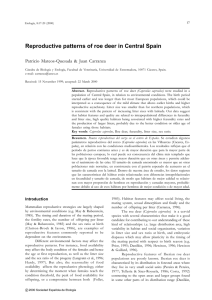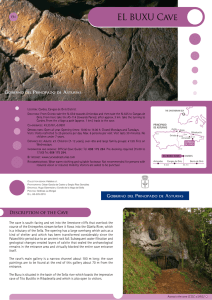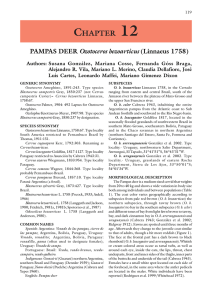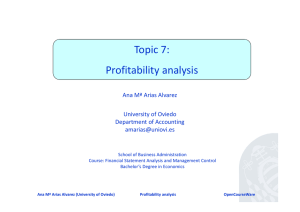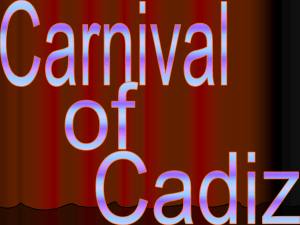Habitat use by roe and red deer in Southern Spain C. San
Anuncio
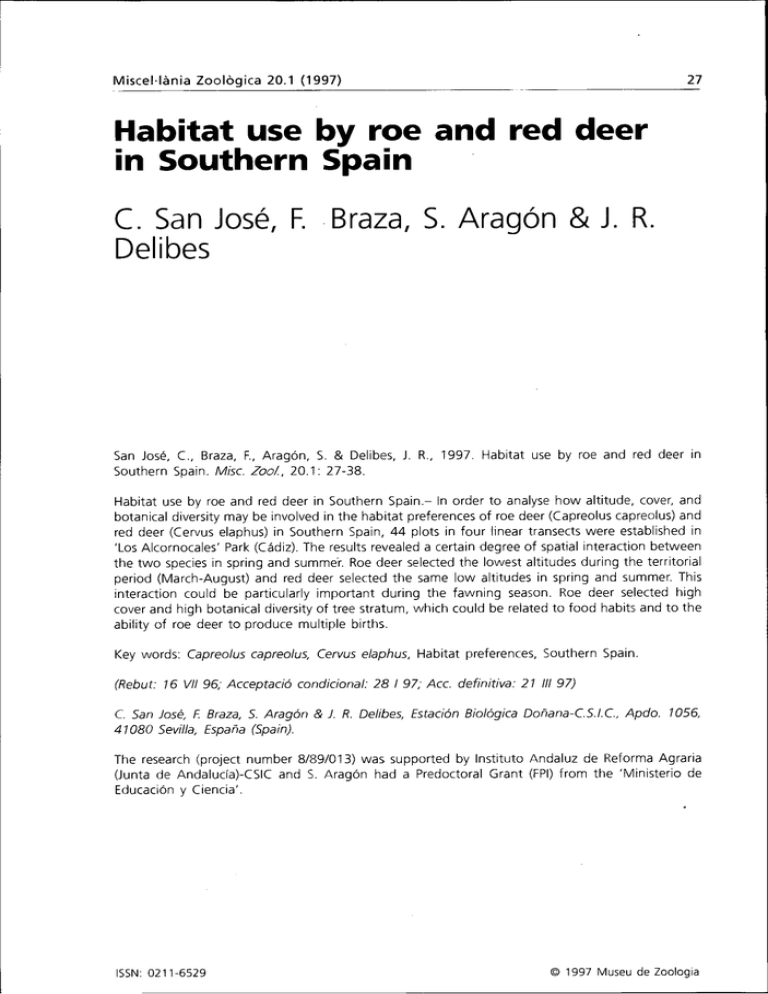
Miscel.lania Zoologica 20.1 (1997)
27
Habitat use by roe and red deer
in Southern Spain
C. San José, F. Braza, S. Aragón & J. R.
Deli bes
San José, C., Braza, F., Aragón, S. & Delibes, J. R., 1997. Habitat use by roe and red deer in
Southern Spain. Misc. ZooL, 20.1: 27-38.
Habitat use by roe and red deer in Southern Spain.- In order to analyse how altitude, cover, and
botanical diversity may be involved in the habitat preferences of roe deer (Capreolus capreolus) and
red deer (Cervus elaphus) in Southern Spain, 44 plots in four linear transects were established in
'Los Alcornocales' Park (Cádiz). The results revealed a certain degree of spatial interaction between
the t w o species in spring and summe'r. Roe deer selected the lowest altitudes during the territorial
period (March-August) and red deer selected the same low altitudes in spring and summer. This
interaction could be particularly important during the fawning season. Roe deer selected high
cover and high botanical diversity of tree stratum, which could be related to food habits and t o the
ability of roe deer t o produce multiple births.
Key words: Capreolus capreolus, Cervus elaphus, Habitat preferences, Southern Spain
(Rebut: 16 VI1 96; Acceptació condicional: 28 1 97; Acc. definitiva: 21 111 97)
C. San losé, F: Braza, S. Aragón & l . R. Delibes, Estación Biológica Doñana-C.S.I.C., Apdo. 1056,
4 1 080 Sevilla, España (Spain).
The research (project number 8/89/01 3) was supported by Instituto Andaluz de Reforma Agraria
(Junta de Andalucía)-CSIC and S. Aragón had a Predoctoral Grant (FPI) from the 'Ministerio de
Educación y Ciencia'.
ISSN: 021 1-6529
O 1997 Museu de Zoologia
San José et al.
lntroduction
where red deer are present in any numbers, evidencing a certain level o f space
In Southern Spain roe deer (Capreolus
segregation between both species (e.g.
capreolus) and red deer (Cervus elaphus) are
WILDASH,1951). In some cases, it seems
sympatric only in the mountain ranges o f
likely that red deer have increased i n many
Cádiz-Málaga (BRAZAet al., 1989b; A R A G ~ N localities at the expenses of roe deer simet al., 199513) but, while the red deer popuply because the forests have been altered
lation has progressively increased in this
and roe deer is more sensitive than red
area during the last ten years, a marked
deer t o environmental changes (BATCHELER,
decrease in the numbers o f roe deer was
1960).
detected i n the 80's (BRAZAet al., 1989a).
Since 1989 an area of 170,000 ha o f cork
Several reasons have been put forward i n
oak forests in the mountain ranges o f Cáorder t o explain this trend i n the roe and
diz has been protected ('Los Alcornocales'
red deer populations. A high influence of
Park). In absence o f large predators, the
density-independent factors on population
management of roe and red deer popudynamics o f roe deer (BOBEK,1977) makes
lations is a very important element in this
this species particularly vulnerable t o
area and accounts for the conservation of
drought in this area. On the other hand,
this ecosystem. In this paper, we analyse
inappropriate hunting management has
how particular variables related t o strucaffected both roe and red deer populations: ture and physical characteristics of the habithe hunting season for roe deer during the
t a t may be involved in the habitat preferfawning period has had a very negative
entes of roe and red deer in Southern Spain.
effect on the reproductive rate and o n fawn
Furthermore, a relatively simple method t o
survival in Cádiz. A t the same time, manageobtain basic periodic information necessary
ment plans have led t o a significant increase
for the management and conservation o f
in the number of red deer in some areas these wild deer populations is described.
(averages o f 34.0 red deerI100 ha and 5.09
roe deerI100 ha; BRAZAet al., 1994a). Furthermore, previous studies in the mountain
Material and methods
ranges of Cádiz have revealed that roe deer
Study area and population
reach the highest values of density (9.6 roe
deer1100 ha; BRAZAet al., 1994a) where red
'Los Alcornocales' Park, where both deer
deer are almost absent, thereby suggesting
species are present, includes mountain
a possible interaction between red deer and
ranges that stretch northwards from the
roe deer.
Strait o f Gibraltar, and are characterized by
Regarding the interactions between the
mean altitudes o f 400-500 m ( t o a maximum
t w o species, a certain level o f dietary overpeak of 1092 m) (fig. 1). Despite the high
lap has been referred t o by different aurainfall (approx. 1000 mm annually), mainly
thors (GOFFIN& DE CROMBRUGGHE,
1976;
HEARNEY
& JENNINGS, 1983; STAINES & WELCH, occurring between October and April, the
most significant climatic factor is a long dry
1984; GOFFIN,1985). In Cádiz, roe and red
summer (mean temperature in the hottest
deer eat the same plant species but show
month: 24-26°C; n = 35 years). During this
different levels o f preferences which, i n
season, water sources are scarce and contheory, could mean a low level o f overlap
centrated at the bottom o f the ravines,
(BRAZAe t al., 1994a). However, it has t o be
where vegetation conserves humidity, while
taken into account that the high number
the hillsides support a more typical Meditero f red deer (bigger in body size than roe
ranean xerophytic woodland.
deer) in the area could represent a negaThe characteristic vegetation o f 'Los
tive pressure o n some food resources preAlcornocales' Park is a rather homogeneous
ferred by roe deer.
cork oak (Quercus suber) forest. However, a
There i s little information available reThermomediterranean layer o f vegetation
garding space competition between roe and
(consisting o f sclerophylous forests w i t h
red deer, although some authors have respecies such as Olea europaea, Ceratonia
ported that roe deer are seldom found
Miscel.lania Zoologica 20.1 (1997)
29
mined by historical factors. The red deer
are the result of reintroductions carried out
from 1956 onwards. The indigenous roe
deer population is at the southern limit of
the species' world-wide distribution. It is of
particular interest that as it is isolated from
other populations in Spain it may be considered a distinct Mediterranean ecotype
(ARAG~N,
1993; A R A G ~
etNal., 1995a; A R A G ~ N
et al., in press).
Hunting of both deer species is allowed
in the study area, but therein roe deer
were not hunted during the study period.
Methods
The study area consisted of four linear
transects (two in each category of bioclimatic
layer), each with eleven circular plots of
80 m2 hundred meters apart. The 44 plots
represent a sample area of 3520 m2. This
method is a useful tool t o determine habitat
preferencesand seasonal distribution of deer
(BATCHELER,
1960; BRAZA
et al., 199413).
The plots (n = 44) were characterized by
the variables: altitude, cover and botanical
diversity (table 1). These variables were selected based on previous results (BRAZAet
al., 1994a) in which a multivariate analysis
method revealed that altitude, cover and
botanical diversity are the main factors affecting the distribution of roe and red deer
in the mountain ranges of Cádiz. Mean slope
of transects varies from 10.5" to 18.7".
Altitude was the same for al1 plots in
Fig. 1. Study area.
each transect, since the precision of the
Area de estudio.
altimeter was higher than variations in each
transect. It should be noted that the uniform value of altitude for plots of the same
transect probably determines a certain level
of similarity between plots within each
siliqua and Pistacia lentiscus), and a transect because some characteristics of the
habitat are related t o particular values of
Mesomediterranean layer (where t h e
altitude.
sclerophylous forests of Quercus suber
Cover (C) refers t o the proportion of an
appear associated t o the species Quercus
area covered by the vertical projection of
rotundifolia, Erica sp., Arbutus unedo, and
plant crown t o the ground surface. It was
Quercus faginea, species which appear in
calculated measuring the two maximum
the most humid regions) (Rivns-MART~NEZ,
perpendicular diameters (DI, D2) of a sin1987) can be differentiated.
gle plant per plot, and multiplying the surA representative area of 5000 ha was
face obtained [assimilating the surface t o
selected as the study area within 'Los Alcoran ellipse, x(D, X D2)/4] by the number of
nocales' Park.
individuals of each species found within
The distribution of both deer species in
the plot (GYSEL
& LYON,1980).
the study area has principally been deter-
3O
S a n José et al.
Altitud (m); CTS. Cobertura
Plot
AL
CTS
CSSS
ClSS
DT
DSSS
DISS
Miscel.lania Zoologica 20.1 (1997)
Following HAIR(1980), we rneasured the
diversity (D) by counting the number of different botanical species present in each plot.
Three separate strata o f vegetation were
considered in order t o calculate cover and
botanic diversity: a) tree stratum (TS higher
than 3m), b) superior stratum o f shrub (555
frorn 1.5 t o 3m), and c) inferior stratum o f
shrub (ISS less than 1.5rn).
The transects were visited rnonthly frorn
August 1989 t o July 1990, recording al1 signs
of roe and red deer presence (tracks, beddings and pellets). Every trace of roe and
red deer found in the plots was removed
after each visit. The frequency o f visits was
decided after evaluating the time of disappearance of traces over the time: pellets
never disappeared in less than one month;
perrnanence of tracks and beddings was variable but similar for both roe and red deer.
These fluctuations were therefore not considered relevant for comparisons between
species. Discrirnination between tracks of both
species was possible by differences in size
and forrn (the rare cases o f doubt were not
included for analysis).
31
Data of presence-absence of roe and red
deer in the 44 plots were analysed over the
year. Variations related t o the different variables considered were tested within months
by the Mann-Witney U test; comparison of
means between both deer species was rnade
by the Wilcoxon test (SIEGEL, 1972). We assume for statistical analysis the independence between plots separated by 100 m.
Results
Mann-Witney U test revealed a significant
selection of particular altitudes by roe and
red deer in sorne particular months: red
deer showed fewer fluctuations than roe
deer on altitudes selected over the year (see
fig. 2, tables 2,3). Both species selected
lower altitudes i n spring and sumrner (fig.
2), w i t h significant levels in March (Z = -2.0,
p = 0.0454), May (Z = -2.54, p = 0.0109),
June (Z = -3.33, p = 0.0009), and August
(2 = -2.31, p = 0.0209) f o r roe deer; and
March (2 = -4.01, p = 0.0001), April (Z = -3.23,
p = 0.0012), May (2 = -2.39, p = 0.0166), and
32
San José et al.
Table 2. Habitat characteristics selected by roe deer over a year: R. Mean; SD.
Standard deviation. (For other abbreviations see table 1.)
Características del hábitat seleccionadas p o r e l corzo a l o largo de u n año: X.
Media; SD. Desviación estándar (Para otras abreviaturas ver tabla 1.)
Months
n
AL
X
SD
CTS
Jan
Feb
Mar
4
5
11
346.2 394.0 237.7
255.4 296.0
Apr May
14
10
Jun
Jul Aug
Sep Oct
16
11
30
5
16
Nov Dec Annual
13
5
140
295.7 192.5 212.8 325.0 158.0 334.3 330.0 255.3 415.0 291.4
170.9 195.5 98.2 154.9 257.7 107.3 222.5 228.2 216.6 260.1
80.5
X -47.7
-
34.8
49.2
44.2
61.0
44.0
43.1
46.2
389
38.0
38.8
19.8
42.1
SD
24.3
25.9
36.0
23.8
37.2
31.3
38.3
33.9 31.2
30.8
29.7
27.4
9.8
CSSS X
25.1
524
44.0
40.2
40.2
26.7
35.5 34.7 34.1
39.7
38.2
45.0
38.0
SD
23.6
14.9
52.3
50.9
20.9
18.7
26.4 24.9
28.5
51.2
20.7
50.8
7.6
X
9.6
14.7
- 6.5
8.4
59
6.4
8.2
8.0
10.3
9.0
7.7
11.4
8.7
SD
7.4
15.7
5.1
6.9
37
4.8
5.9
3.0
9.6
7.7
6.7
9.9
2.6
X
2.0
1.5
1.3
1.9
2.0
1.7
1.9
1.6
1.5
1.6
1.7
1.8
1.9
ClSS
DTS
June (Z = -2.49, p = 0.0126) f o r red deer
(Mann-Witney U test; n = 44). During the
autumn (October: Z = -2.17, p = 0.0301, for
red deer; November: Z = -2.19, p = 0.0284,
for roe deer; Mann-Witney U test; n = 44)
l o w altitudes were still selected (fig. 2).
Regarding cover of the tree stratum, roe
deer tended t o select plots with higher tree
cover in spring and summer than in the rest of
the year, though a significant level was only
reached in May (Z = 2.13, p = 0.0333; MannWitney U test; n = 44) (fig. 3, table 2).
A preference for higher levels of cover at
the superior stratum of shrub was found for
roe deer in February (Z = -2.42, p = 0.0154;
Mann-Witney U test; n = 44). Roe and red
deer preferred low cover at the inferior stratum of shrub over the year (fig. 3); a significant level in June for roe deer (Z = -2.29,
p = 0.0218), and in March (Z = -1.95, p = 0.05)
and May (Z = -1.96 p=0.04) for red deer
(Mann-Witney U test; n = 44).
Roe deer preferred higher tree diversity,
particularly in March, and a higher diversity at the inferior stratum o f shrub in September (Z = -2.36, p = 0.018, and Z = -2.13,
p = 0.0334, respectively; Mann-Witney U
test; n = 44) (fig. 4, table 2).
As regards red deer (fig. 4, table 3), the
botanical diversity of any strata of vegetation had no significant influence on monthly
habitat selection by this species (MannWitney U test; n = 44).
Comparing the means of plots selected
by roe and red deer over a year (tables 2,3),
significant differences were only found with
respect t o botanical diversity of the tree
stratum: roe deer selected plots with higher
tree diversity than red deer (Z = - 2.581,
p = 0.01; Wilcoxon test; n = 12).
Miscel.lania Zoologica 20.1 (1997)
33
Table 3. Habitat characteristics selected by red deer over a year: R.
Standard deviation. (For other abbreviations see table 1.)
Características del hábitat seleccionadas por el ciervo a lo largo de
Media; SD. Desviación estándar. (Para otras abreviaturas ver tabla 1.)
Discussion
Despite the difficulty in analysing the interaction between two species with different
spatial and social behaviours, and different
historical origins in a very wide area, and
despite the limitation of rnethods, the exploratory nature of the research justifies the
discussion thereof with the view t o generate further studies which rnay contribute t o
the conservation and management of roe
and red deer in Mediterranean habitats.
The fluctuations in the altitudes selected
by roe deer over the year, in contrast with
the relatively constant mean altitude maintained by red deer in their ranging behaviour, constitute an interesting difference in
the space distribution of the two species.
This result probably reveals a higher sensitivity of roe deer t o seasonal bioclimatic
variations and environmental changes in comparison with red deer.
At this point i t should be taken into
account how roe deer selected the lowest
altitudes during the territorial period
(March-August). In Cádiz these low areas
selected by roe deer are the deep, dark,
closed gullies which constitute protected
refuges and conserve hurnidity during the
dry season. As pointed out by BOBEK(1977),
food resources are an irnportant factor determining the number of resident roe bucks
and does during the sumrner season. During the long and dry summer in the cork
oak forests of Cádiz, probably the available resources of the deep gullies (where
the only permanent water sources are located) determine the carrying capacity of
the habitat.
Furtherrnore, red deer also select low
San José et al.
ROE DEER
600 T
-
absent
A
present
Fig. 2. Mean altitude of plots with
presencelabsence o f roe and red deer
over the year: n. Nu
* p < 0.05; ** p
Mann-Witney U
Altitud media
presencialausencia
d u r a n t e u n año: n.
parcelas;* p < 0.05; ** p < 0.07; ***
p < 0.007; test de la U de MannWitnev.
altitudes throughout most o f the spring
and summer. A space interaction between
roe and red deer may therefore exist in
this period. Such interaction could be particularly important during the fawning season which is May for both species. Since
roe and red deer use a 'hider' strategy
e t al.,
during the fawning season (GUINNESS
1978; JULLIEN e t al., 1992) particular conditions o f the habitat mav determine the
selection o f similar places for hiding fawns
by both roe and red deer.
Our results suggest that while red deer
do not select particular cover (at any strata
o f vegetation) during the fawning season,
roe deer do prefer high levels o f tree cover
in May. Therefore, although both species
coincide in selecting the same low altitudes
in spring and surnmer, there is a certain
level o f segregation between them during
the fawning season, since roe deer prefer
higher levels o f tree cover.
In general, roe deer give birth t o t w o
fawns per year while red deer give birth t o
only one fawn (CHAPMAN
& CHAPMAN,1971;
PUTMAN,1988). It seems that species with the
ability t o produce multiple births are particularly susceptible t o nutritional or abiotic
influences, because both litter size and the
proportion o f females conceiving can be
affected by such factors (BUNNELL,
1982). Our
results support this hypothesis, since roe deer
selected a greater tree diversity than red
deer. This finding is also in line with the
food habits of roe deer, a selective-concentrate feeder (PUTMAN,
1988), which, in Southern Spain, include a high level of ligneous
et al., 1987; BRAZA
et al., 1994a).
plants (FANDOS
There is evidence that nutrition of roe and
red deer females during winter and spring
influences their body condition and fecundity (CLUTTON-BROCK
et al., 1982; LOUDON,
1982;
RATCLIFFE
& MAYLE,1992).
Another aspect t o be considered is the
difference between the population regulation mechanisms of red and roe deer. The
roe deer reproductive rate probably results
from spring social regulation of the population through territorial behaviour (densityindependent reproductive rate) (BRAMLEY,
1970; STRANDGAARD, 1972; BOBEK,1977) while
population density regulates red deer populations by affecting reproductive rates and
mortality (CLUTTON-BROC~
et al., 1982).
Considering the low variability in the
number o f corpora lutea per female roe
deer found in different wild European populations (average of 2.0 2 0.2; BOBEK,
1977), it
i s probable that the very low reproductive
rate detected in the roe deer population of
Cádiz (BRAZAet al., 1994a) could be caused
Miscel.lania Zoologica 20.1 (1997)
35
RED DEER
ROE DEER
-o- absent
-e present
Fig. 3. Mean cover o f the different strata of vegetation o f plots with presence/absen
of roe and red deer over the year: n. Number o f plots; * p < 0.05; ** p < 0.01; Man
Witney.U test. (For other abbreviations see table 1.)
Cobertura media con presencialausencia de ciervo y corzo durante u n año: n.
Número de parcelas; * p < 0.05; ** p < 0.01; test de la U de Mann-Witney . (Para otras
36
San José et al.
RED DEER
ROE DEER
LLI <
LL
<
9
9
7
6
5
4
3
2
1
0
I
0
ZZ
Z M Cd Cd
UJ «:(
x <
LL
I
I
I
co
W
K
K
111141+
O.
›- Z
cn
—0—absent
—•—present
Fig. 4 Mean botanical diversity of the different strata of vegetation of plots with
presence / absence of roe and red deer over the year: n. Number of plots; *p < 0.05;
** p < 0.01; Mann-Witney U test. (For other abbreviations see table 1.)
Diversidad botànica media con presencia / ausencia de ciervo y corzo durante un
afio: n. Número de parcelas; * p < 0.05; ** p < 0.01; test de la U de Mann-Witney.
(Para otras abreviaturas ver tabla 1.)
I
Miscel.lania Zoolosica 20.1 (1997)
by miscarriages or by a high mortality rate
of fawns during their first days of life. This
fawn mortality may result from infections
(GIRAUD,1984; L E ~ et
N al., 1994). but i t is
probably also a consequence of the impact
of predators (¡.e., Vulpes vulpes) on fawns
and the interaction detected with red deer
during the fawning season.
Taking into account that roe deer from
the mountain ranges of Cádiz can be
considered a locally isolated ecotype
( A R A G ~ 1993;
N,
A R A G ~etNal., 1995a; ARAG6N et al., in press), future studies are
necessary t o evaluate the factors directly
influencing the regulation of this population. Such information about the interactions w i t h red deer will help us t o
understand the adaptive mechanisms of
these t w o species t o the Mediterranean
xerophytic forests.
Acknowledgements
We thank the 'Consejería de Medio Ambiente'
and the 'Oficinas de los Parques Naturales de
Grazalema y de Los Alcornocales' for their
collaboration in our field work. We thank Dr.
Bideau for the revision of the manuscript. We
thank also Enrique Collado for his help in
statistic analysis and in the discussion of our
paper, and Alicia Prieto for the last correction
of the manuscript.
Resumen
Uso del hábitat por el corzo y el ciervo en el
sur de España
Con objeto de analizar la influencia de la
altitud, cobertura y diversidad botánica en
las preferencias de hábitat del corzo
(Capreolus capreolus) y el ciervo (Cervus
elaphus) en el Sur de España, se establecieron 44 parcelas en cuatro transectos lineales
situados en el Parque de "Los Alcornocales"
(Cádiz) (fig. 1). Los resultados revelaron un
cierto grado de interacción espacial entre
ambas especies en primavera y verano. El
corzo seleccionó las altitudes mas bajas durante el período territorial (marzo-agosto) y
el ciervo seleccionó igualmente altitudes bajas
en primavera y verano (fig. 2). Esta interacción
espacial puede ser particularmente importante durante el período de cría. El corzo
seleccionó altos niveles de cobertura y diversidad arbórea (figs. 3, 4, tabla 2). lo que
podría estar relacionado con los hábitos alimenticios del corzo, así como con su capacidad de partos múltiples. Corzo y ciervo seleccionaron preferentemente un bajo nivel de
cobertura en el estrato inferior arbustivo
(fig. 3). La diversidad botánica no tuvo aparentemente influencia en la variación
estaciona1 de la selección de hábitat por el
ciervo (fig. 4, tabla 3).
References
A R A G ~ NS.,, 1993. E l corzo (Capreolus
capreolus) en Cádiz. Caracterización y
encuadre de sus poblaciones en el conjunto de la especie. Tesis doctoral, Universidad de Sevilla.
ARAG~N,
S., BRAZA,F. & SAN JosÉ, C., 1995a.
Características morfológicas de los corzos
(Capreolus capreolus) de las sierras de
Cádiz-Málaga. Doñana Acta Vertebrata,
22(1-2): 51-64.
- 1995b. Socioeconomic, physionomic, and
climatic factors determining the distribution pattern of roe deer Capreolus
capreolus in Spain. Acta Theriologica,
40(1): 37-43.
- In press. Variation in skull morphology
of roe deer (Capreolus capreolus) in Western-Central Europe. J. Mammal.
BATCHELER,
C. L., 1960. A study of the relation between roe, red and fallow deer,
with special reference t o Drummond hill
forest, Scotland. lournal o f Animal Ecology, 29: 375-384.
BOBEK,
B., 1977. Summer food as the factor
limiting roe deer population size. Nature, 268: 47-49.
BRAMLEY,
P. S., 1970. Territoriality and reproductive behaviour of roe deer. J. Reprod.
Fert., 11: 43-70.
BRAZA,
F., SAN JosÉ, C., DELIBES,
J. R. & ARAG~N,
S., 1994a. El corzo andaluz. Ed. Junta de
Andalucia, Sevilla.
BRAZA,
F., SORIGUER, R. C., SAN JosÉ, C., DELIBES,
S., FANDOS, P. & L E ~ NL.,
,
J. R., ARAGON,
1994b. Métodos para el estudio y manejo
de cérvidos. Ed. Junta de Andalucía, Sevilla.
San José et al.
ology, London, 185: 105-114.
V., 1989a. Les
BRAZA,F., VARELA,l. & CASES,
GYSEL,L. W. & LYON, L. J. 1980. Habitat
populations de chevreuils (Capreolus
analysis and evaluation. In: Wildlife Mancapreolus) dans la sierra de Cadix (sud
agement Techniques Manual: 305-327 (S.
Espagne). Bulletin Mensuel Office NatioD. Schemnitz, Ed.).The Wildlife Society,
n a l de la Chasse, 135: 25-28.
Inc., Washington, D. C.
BRAZA,F., VARELA,l., SAN JosÉ, C. & CASES,
V.,
HAIR,J. D. 1980. Measurement o f ecological
1989b. Distribution actuelle du chevreuil
diversity. Habitat analysis a n d evalua(Capreolus capreolus), du daim (Dama
tion. In: Wildlife Management Techdama) e t d u cerf (Cervus elaphus) en
Espagne. Zeitschrift fur Saugetierkunde,
niques Manual: 269-275 (S. D. Schemnitz,
Ed.). Washington, D. C.
54: 393-396.
HEARNEY,
A. W. & JENNINGS, T. J., 1983. Annual
BUNNELL,
F. L., 1982. Reproductive tactics of
f o o d s o f t h e r e d deer (Cervus
cervidae and their relationships t o habitat.
elaphus) and t h e roe deer (Capreolus
In: Biology a n d management o f the
capreolus) in the east of England. l o u r cervidae: 145-167 (C. M. Wemmer, Ed.). Ed.
n a l Zoology, London, 201 : 565-570.
Srnithsonian lnstitution Press, Washington.
JULLIEN, J. M., DELORME,
D. & GAILLARD,
J. M.,
CHAPMAN,
D. l. & CHAPMAN,
N. C., 1971. Fur1992. Détermination de I'age chez le
ther observations o n the incidence o f
faon de chevreuil (Capreolus capreolus)
twins i n roe deer, Capreolus capreolus.
dans son premier mois de vie. Mammalia,
l o u r n a l o f Zoology, London, 23: 505-544.
CLUT~ON-BROCK,
T. H., GUINNESS,
F. E. & ALBON,
56(2): 307-312.
LEÓN, L., ASTORGA,
R. & CUBERO,
M. J., 1994.
S. D., 1982. Red deer: behaviour a n d
ecology o f t w o sexes. Ed. Edinburgh UniAproximación al estado sanitario de los
corzos andaluces. In: El corzo andaluz:
versity Press, Edinburgh.
85-97. Ed. Junta de Andalucia, Sevilla.
FANDOS, P., MART~NEZ,
T. & PALACIOS,
F., 1987.
Estudio sobre la alimentación del corzo
LOUDON,A. S. l., 1982. The influence o f
(Capreolus capreolus L. 1758) en España.
forest habitat structure on growth, body
size a n d r e p r o d u c t i o n i n r o e deer
Ecologia, 1: 16 1- 186.
(Capreolus capreolus L.). In: Biology a n d
GIRAUD,C., 1984. Brucellose de chevreuil.
management o f the cervidae: 159-597
Des observations dans les Hautes(C. M. Wemmer, Ed.). Ed. Smithsonian
Pyrénées. B u l l e t i n l n f o r m a t i f sur la
lnstitution Press, Washington.
Pathologie des Anirnaux Sauvages de
PUTMAN,R., 1988. The natural history o f
France, 2: 67-69.
deer. Ed. Christopher Helm, London.
GOFFIN,R. A., 1985. Définition d u potenRATCLIFFE,
P. R. & MAYLE,B. A., 1992. Roe deer
t i e l alimentaire pour le cerf (Cervus
elaphus L.) e t d u chevreuil (Capreolus
biology and management. Forestry Comcapreolus L.) et évaluation de la pression
mission Bulletin, 105: 1-28.
RIVAS-MART~NEZ,
S., 1987. Memoria del mapa
exercée par les mémes dans trois types de
de series de vegetación de España. Ed.
peuplements forestiers de I'Ardenne
ICONA, Madrid.
belge. In: XVllth Congress o f the lnternational Union o f Game Biologists: 385-391
SIEGEL, S., 1972. Estadística n o paramétrica.
Ed. Trillas, México.
(S. A. de Crombrugghe, Ed.). Ministere
de Agriculture, Brussels (Belgium).
STAINES, B. W. & WELCH,D., 1984. Habitat
selection and impact of red deer (Cervus
GOFFIN,R. A. & DECROMBRUGGHE,
S. A., 1976.
elaphus) a n d r o e deer (Capreolus
Régime alimentaire d u cerf (Cervus
capreolus) in a Sitka spruce plantation.
elaphus) e t d u chevreuil (Capreolus
capreolus) et criteres de capacité staProc. Roy. Soc. Edinburgh, 828: 303-319.
tionelle de leurs habitats. Mammalia,
STRANDGMRD, H., 1972. The roe deer population
at Kalo and the faaors regulating its size.
40(3): 355-376.
GUINNESS,
F. E., GIBSON,
R. M. & CLUTTON-BROCK, Danish Review o f Game Biology, 7: 1-25.
WILDASH,
H., 1951. Roe deer in Austria. lournal
T. H., 1978. Calving time of red deer
o f Forestry Commission, 22: 122-5.
(Cervus elaphus) on Rhum. l o u r n a l o f Zo-
